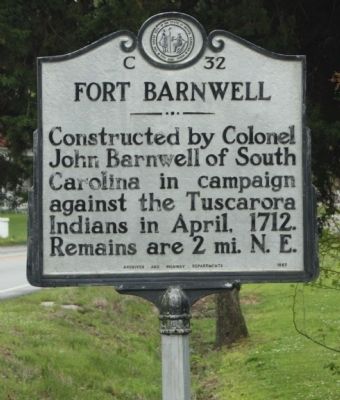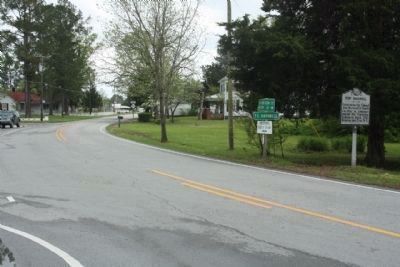Fort Barnwell in Craven County, North Carolina — The American South (South Atlantic)
Fort Barnwell
Erected 1957 by Archives and Highway Departments. (Marker Number C-32.)
Topics and series. This historical marker is listed in these topic lists: Colonial Era • Forts and Castles • Settlements & Settlers. In addition, it is included in the North Carolina Division of Archives and History series list. A significant historical month for this entry is April 1712.
Location. 35° 17.525′ N, 77° 20.161′ W. Marker is in Fort Barnwell, North Carolina, in Craven County. Marker is on State Highway 55 near Belltown & Biddle Roads, on the right when traveling south. Touch for map. Marker is at or near this postal address: 9390 Highway 55, Dover NC 28526, United States of America. Touch for directions.
Other nearby markers. At least 8 other markers are within 12 miles of this marker, measured as the crow flies. Washington's Southern Tour (within shouting distance of this marker); Ervin T. Rouse (approx. 3½ miles away); Burney Place (approx. 5.8 miles away); Catechna (approx. 8.2 miles away); John Lawson (approx. 8.2 miles away); Blount Hall (approx. 9.4 miles away); Tower Hill (approx. 10.6 miles away); Battle of Wyse Fork (approx. 11.2 miles away).
Regarding Fort Barnwell. John Barnwell emigrated from Ireland to South Carolina in 1701. By the time of the Tuscarora War (1711-1713), he was a trusted official in the colony. Meanwhile, in North Carolina, preceiving a threat from the establishment of a Swiss colony at New Bern, Tuscarora Indians massacred settlers in that area. On September 22, 1711, over 130 colonists lay dead and even more were wounded or captured. When North Carolina called on its neighbors for aid, South Carolina sent Colonel John Barnwell. In January of 1712, he led a militia of thirty soldiers and 500 Indian allies to attack the Tuscarora fort, Narhantes (also known as Torhunta), on the Neuse River. According to Barnwell, Fort Narhantes was the Tuscarora’s largest and most warlike village. Despite several casualties, Barnwell took the fort on January 29, 1712.
After the victory at Narhantes, Barnwell then advanced to the Tuscarora’s fort in the village of Catechna. The Tuscarora successfully held off two attacks and, in order to save the white prisoners inside, Barnwell entered into a truce in exchange for their freedom. As part of the truce, twelve prisoners were released immediately and twenty-two were to be delivered twelve days later at Bachelors Creek near New Bern. When the appointed day came, the Tuscarora did not bring the prisoners. In preparing to strike again, Barnwell built Fort Barnwell on the site of the
abandoned Indian village of Core Town near the mouth of Contentnea Creek on the Neuse River. From that base he planned to march once again on Hancock’s Fort. On April 7, 1712, Barnwell led a ten-day siege against the fort. On April 17, with his men starving, Barnwell accepted the Tuscarora’s conditional surrender by which they gave up all of their prisoners, agreed not to hunt or fish in the region between the Neuse and the Cape Fear, and surrendered their chief, King Hancock. Many were critical of Barnwell for accepting the surrender rather than fighting on to total victory. Barnwell broke the treaty when his men lured some Indians into Fort Barnwell under the pretense of peace only to capture them and carry them to South Carolina to be sold into slavery.
The Tuscarora were finally defeated in 1713 when Colonel James Moore led his men and Yamasee Indians into the Tuscarora village of Nooherooka and killed or captured approximately one thousand inhabitants. Around 1800 the northwestern Craven County community of Fort Barnwell was settled. The remains of the old fort can be found on a bluff overlooking the Neuse River two miles northeast of the community. (North Carolina Office of Archives & History — Department of Cultural Resources)
Credits. This page was last revised on June 24, 2021. It was originally submitted on June 5, 2013, by Mike Stroud of Bluffton, South Carolina. This page has been viewed 1,707 times since then and 243 times this year. Photos: 1, 2. submitted on June 6, 2013, by Mike Stroud of Bluffton, South Carolina.

